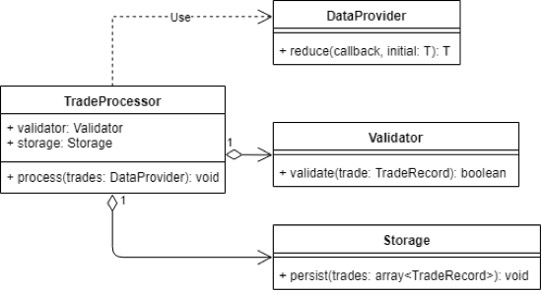Single Responsibility Principle (SRP)
A class should have one and only one reason to change, meaning that a class should have only one job- Classes, software components and microservices that have only one responsibility are much easier to explain, understand and implement than the ones that provide a solution for everything
- This reduces the number of bugs, improves your development speed, and makes your life as a software developer a lot easier
- Unfortunately, following the single responsibility principle sounds a lot easier than it often is
- If you build your software over a longer period and if you need to adapt it to changing requirements, it might seem like the easiest and fastest approach is adding a method or functionality to your existing code instead of writing a new class or component
- But that often results in classes with more responsibilities and makes it more and more difficult to maintain the software
- You can avoid these problems by asking simple questions before you make any changes:
- Is this class doing too much?
- Correct answer: No, it is responsible for only one specific functionality
- How many sources of new requirements does this class have?
- Correct answer: Single source or new requirements
- Who is this class responsible to?
- Correct answer: It is only responsible to one person or role
- Is this class doing too much?
Bad Example
- Suppose we have
TradeProcessorclass, which purpose is to retrieve trade operations from one data source and transfer them to anotherTradeProcessorclass responsibilities are:- read each line from the Stream parameter
- parse fields from each line and store them in an array of TradeRecord instances with validation
- iterate over an array of TradeRecord instances and save them to the database
class TradeProcessor {
public process(stream: Stream) {
const connection = new DBConnection(/* */);
const reader: StreamReader = new StreamReader(stream);
const lines: string[] = reader.readLines();
lines
.reduce((records: TradeRecord[], line: string) => {
const fields = line.split(",");
if (fields.length !== 2) {
/* handle format validation error */
}
const [amount, price] = [
parseInt(fields[1], 10),
parseInt(fields[2], 10),
];
if (amount < 0 || price < 0) {
/* handle trade validation error */
}
return [...records, new TradeRecord(amount, price)];
}, [])
.forEach((trade: TradeRecord) => {
connection.save(trade);
});
connection.close();
}
}
SRP states that class should have only one reason to change
- However, the reality of TradeProcessor is that it will change under the following circumstances:
- You need to change the data source from the stream to the REST API
- The data format needs to be changed
- Validation rules have changed
- When the procedure for saving data to the database changes
- for example, instead of mapping incoming parameters to a database table, we will save them in several tables with foreign keys
- However, the reality of TradeProcessor is that it will change under the following circumstances:
Now you need to ask "Who is to blame for the changes?"
- Having answered it, you will divide the requirements into three groups of responsibilities
What to do next?
- Separate the interfaces and as a result make the class follow SRP
- So, the first step in refactoring
TradeProcessoris to create interfaces that will be used to perform three high-level tasks:- reading
- processing
- storing trade data
- In accordance with the SRP, three main responsibilities will be carried out by three different classes
You may ask: What if we already have clients who use
TradeProcessorin its previous implementation?- This is a valid question, and ideally you should already have an interface or abstract processor class allocated
- We just add a new processor implementation in the form of an adapter composing the new version and adjusting it to the old interface
- If we do not have such abstraction, then we can implement the adapter directly in the current processor implementation, declare it deprecated and remove it in the next version of the application/library

Good Example
class TradeProcessor {
constructor(private validator: Validator, private storage: Storage) {}
public process(trades: DataProvider) {
const validTrades = trades.reduce(
(validTrades: TradeRecord[], trade: TradeRecord) => {
if (!this.validator.isValid(trade)) {
/* handle invalid data */
}
return [...validTrades, trade];
},
[]
);
this.storage.persist(validTrades);
}
}
Summary
- essence of SRP is to combine code that changes for 1 reason and separate the code that changes for another
- the principle suggests that we draw boundaries between modules so that a change in business rules affects as few modules as possible, ideally one
- benefits of SRP
- encourages the creation of modules that change for only 1 reason
- it helps to limit the impact of these changes and control the complexity of the program
- the principle allows you to reduce the amount of code (modules) that needs to be changed when changing business rules
- encourages the creation of modules that change for only 1 reason
When to use?
- Your module is constantly changing and the requirements for changes come from different roles in your project
- The actions in the module do not correlate with each other
- The logic in the module is too complex to understand and / or test
How to apply?
- Combine things that change for one reason. Separate things that change for different reasons
- Isolate changes, separate the component parts of the module logically
- Reduce dependencies
- Apply the principle only when it matters. Do not introduce extra dependencies